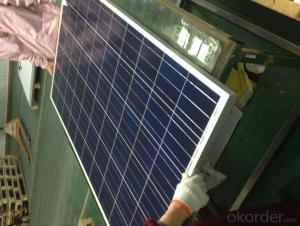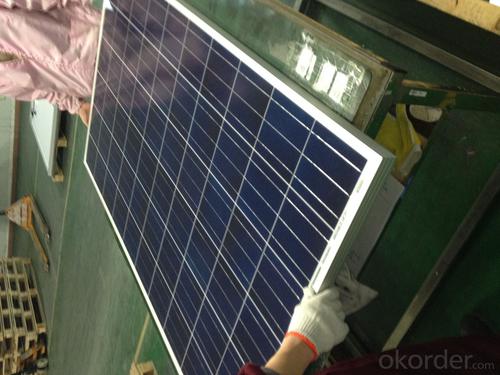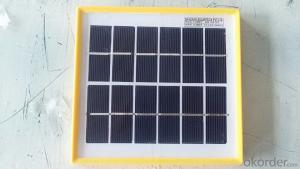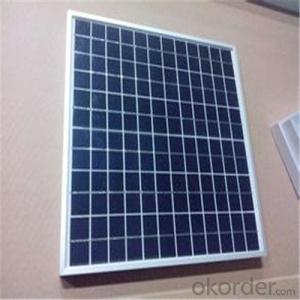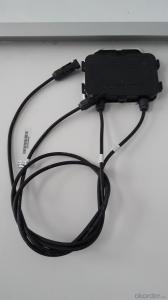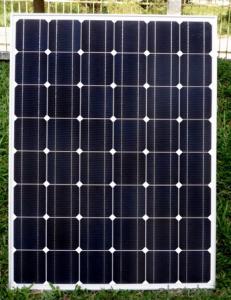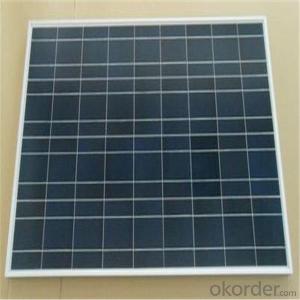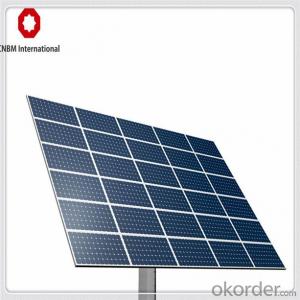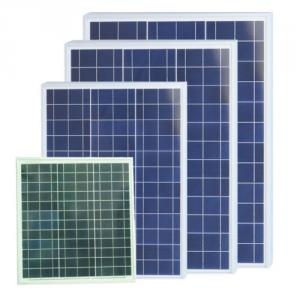Light Weight Solar Panels - 300W Good Quality and Low Price
- Loading Port:
- Shanghai
- Payment Terms:
- TT OR LC
- Min Order Qty:
- 8000 watt
- Supply Capability:
- 100000000 watt/month
OKorder Service Pledge
OKorder Financial Service
You Might Also Like
Roof-based mounting supports include:
Pole mounts, which are attached directly to the roof structure and may use additional rails for attaching the module racking or frames.
Ballasted footing mounts, such as concrete or steel bases that use weight to secure the panel system in position and do not require through penetration. This mounting method allows for decommissioning or relocation of solar panel systems with no adverse effect on the roof structure.
All wiring connecting adjacent solar modules to the energy harvesting equipment must be installed according to local electrical codes and should be run in a conduit appropriate for the climate conditions.
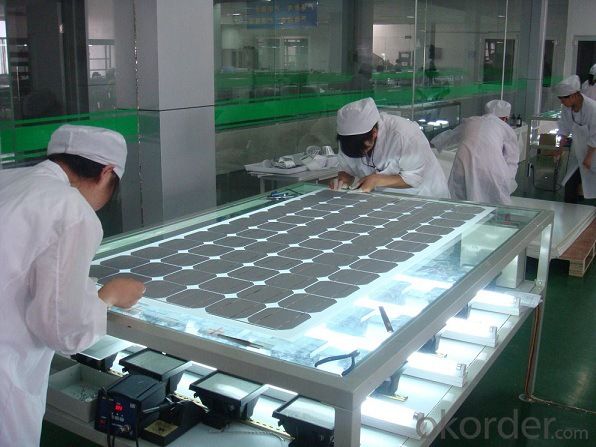
Specifications
solar panels from 5W--300W, made of TAIWAN MOTECH brand cells,with CO in TAIWAN,Mono and Poly with VDE,IEC,CSA,UL,CE,ISO.
We import solar cells from Taiwan Motech brand, with this CO in taiwan and our CSA certification,we can still sell goods to Anti-dumping areas like USA. Our main products are solar panels, off grid and on grid solar home systems , solar street lighting systems, solar water heating system,solar pump,solar attic fan, solar DC LED lights and solar DC refrigerators.
Certificates : ISO, CE, VDE IEC, MCS, CSA-UL, CEC.
Delivery time: sample 10days, order 25-30days.
Sample: charged.
Payment term: T/T 30% as deposit, 70% before shipment. Or irrevocable L/C at sight.
Trade term: FOB Shenzhen or CIF destination seaport or Airport.
Characteristics:
I.Solar Cell : High efficiency crystalline solar cell. Even if under the weak light, the solar module can produce maximum power output.
II.Tempered glass (toughened glass): Anti-reflecting coating and high transmission rate glass increase the power output and mechanical strength of solar module.
III.EVA and TPT: Using high quality EVA and TPT to prevent destroying and water.
IV.AI frame: Without screw, corner connection. 6 holes on the frame can be installed easily.
V.Junction box: Multi function junction box with water proof.
VI.Long lifetime: ≥25 years; Less power decrease.
VII.Good performance of preventing from atrocious weather such as wind and hails.
VIII.Resisting moisture and etching effectively, not effected by geology.
IX.The certificate issued by international authority: UL, TUV, IEC, VDE, CE.
Quality and Safety
1. Rigorous quality control meets the highest international standards.
2. High-transmissivity low-iron tempered glass, strong aluminium frame.
3. Using UV-resistant silicon.
4. IS09001/14001/CE/TUV/UL
Warranties
1. 10 years limited product warranty
2. 15 years at 90% of the minimal rated power output
3. 25 years at 80% of the minimal rated power output
Technical date :
ITEM NO.: | Poly 156*156 cell ,60pcs . Power range from 230Wp-260Wp | ||||||
Maximum Power(W) | 230 | 235 | 240 | 245 | 250 | 255 | 260 |
Optimum Power Voltage(Vmp) | 29.4 | 29.5 | 29.7 | 30.1 | 30.3 | 30.5 | 30.7 |
Optimum Operatige Current(Imp) | 7.83 | 7.97 | 8.08 | 8.14 | 8.25 | 8.37 | 8.48 |
Open Circuit Voltage(Voc) | 36.7 | 36.8 | 36.9 | 37.1 | 37.3 | 37.5 | 37.7 |
Short Circuit Current(Isc) | 8.52 | 8.59 | 8.62 | 8.65 | 8.69 | 8.73 | 8.78 |
Solar Cell: | 156*156 Poly | ||||||
Number of Cell(pcs) | 6*10 | ||||||
Name of Solar Cells | Polycrystalline Cell | ||||||
Size of Module(mm) | 1650*992*40/45/50 | ||||||
Cable & Connector Type | Pass the TUV Certificate | ||||||
Frame(Material Corners,etc.) | Aluminium-alloy | ||||||
Back sheet | TPT | ||||||
Weight Per Piece(KG) | 19.5KG | ||||||
FF (%) | 70-76% | ||||||
Junction Box Type | Pass the TUV Certificate | ||||||
Tolerance Wattage(e.g.+/-5%) | ±3%, or 0-3% | ||||||
Front Glass Thickness(mm) | 3.2 | ||||||
Temperature Coefficients of Isc(%) | +0.04 | ||||||
Temperature Coefficients of Voc(%) | -0.38 | ||||||
Temperature Coefficients of Pm(%) | -0.47 | ||||||
Temperature Coefficients of Im(%) | +0.04 | ||||||
Temperature Coefficients of Vm(%) | -0.38 | ||||||
Temperature Range | -40°C to +85°C | ||||||
Surface Maximum Load Capacity | 5400Pa | ||||||
Allowable Hail Load | 23m/s ,7.53g | ||||||
Bypass Diode Rating(A) | 12 | ||||||
Warranty | 90% of 10 years, 80% of 25 years. | ||||||
Standard Test Conditions | AM1.5 1000W/ 25 +/-2°C | ||||||
Packing | carton or pallet | ||||||
1*20' | 14 Pallets / 316pcs | ||||||
1*40'STD | 25 Pallets / 700pcs | ||||||
FAQ
I..Will you focus on the safety of the goods during transportation?
Yes, Safety of the cargo is the primary element that we would consider on transportation.
II..How would guarantee the quality will meet the requirements of your clients?
Before shipment, we will have inspection for each batch of goods.
III..What certificates do you have?
IEC,UL,TUV,CSA,etc.
IV..Can you do OEM according to clients’ requirements?
Yes, we have our own brand while we can provide OEM service.
- Q: Can solar panels be installed on a house with a flat roof?
- Yes, solar panels can be installed on a house with a flat roof.
- Q: Can solar panels be used for powering Wi-Fi networks?
- Yes, solar panels can be used to power Wi-Fi networks. Solar panels convert sunlight into electricity, which can then be used to power various devices, including Wi-Fi routers. This allows for the establishment of Wi-Fi networks in remote locations or areas with limited access to electricity grids. Additionally, solar-powered Wi-Fi networks are environmentally friendly and sustainable.
- Q: What things can a solar panel power?
- if you have 0 big panel eg: say of 200watts and have 6 hours of proper sunlight.. so u will have 2000watts of energy 2Kw of energy per day.. it depends what is ur household usage.. a 00W bulb for 6hrs= 600W a TV may be 400W for 8 hrs =3200watts.. calculate like this for each equipment u have.. or ucan calculate ur daily use from ur meter... also u need enough batteries for storage and an inverter to covert the DC energy to AC energy.. solar can power anything if it is efficiently stored and generated... depends on the no of panels u have ..area you have for installation......... the cost u can afford.. a 200W solar panel may cost 35000 - 40000 in india..
- Q: I would like to know how do you build a solar panel?
- i think the evil Genius book has how to build home made solar cells.
- Q: Can solar panels be installed on airports or transportation hubs?
- Yes, solar panels can be installed on airports or transportation hubs. In fact, many airports and transportation hubs worldwide have already adopted solar energy systems to power their operations and reduce their carbon footprint. Installing solar panels on these facilities not only helps generate clean energy but also provides an opportunity for sustainable and renewable power sources.
- Q: Can solar panels be installed on a church or place of worship?
- Yes, solar panels can be installed on a church or place of worship. In fact, many religious institutions have embraced solar energy as a sustainable and environmentally-friendly solution for their energy needs. Installing solar panels on a church can help reduce energy costs, lower carbon footprint, and demonstrate a commitment to stewardship of the earth's resources. Additionally, solar panels on a place of worship can serve as a symbol of the institution's values and inspire the community to adopt clean energy practices.
- Q: I thought that I had a fairly good understanding of watt's law, but i'm starting to doubt myself.If I have a load of 4500watts at 240 volts, how many watts of solar panels do I need, if the solar panels are at 2v?Yes, Yes... I have a charge controller, batteries, etc...So the way I looked at this at first:watts = volts * amps For the load4500 = 240 * xx would be 8.75aFor the power source (each solar panel)00 = 2 * xx would be 8.3a8.75 / 8.3 = 2.25, rounded up = 3So... based on that I came to the conclusion that I needed 3 solar panels...But... then I was thinking. Does it work that way?Or do I need 4500 / 00 = 45, aka 45 solar panels?In other words...If I have a 2v power source, how many watts do I need to drive a load of 4500w at 240v?ThanksMatt
- The easy way is to just use the power values. You need 4500W. Each solar panel delivers 00W (from a value in your working). Therefore you need 4500/00 = 45 solar panels. This is a crude calculation, ignoring efficiencies, voltage conversion losses and losses due to internal resistance. You would probably need quite a few more than 45 panels. ___________________________ I'll explain how to do the calculation your way. Each solar panel delivers 00W with a voltage of 2V. So the current is 00/2 = 8.333A. Each solar panel delivers 8.333A at 2V. But you require 8.75A at 240V panel delivers 00W. To get 4500W, you need: 8.75/8.333 = 2.25 times more panels to increase the current AND 240/2 = 20 times more panels to increase the voltage. So overall you need 2.25 x 20 = 45 panels. Of course if the power output of each solar panel is not 00W, you have to change the above calculation accordingly.
- Q: Do solar panels require regular inspections?
- Yes, solar panels do require regular inspections to ensure their optimal performance and detect any potential issues or damage that may affect their efficiency.
- Q: I really need to know about the good companies who are selling good quality home solar panels.I lives in Pakistan, solar panels sell here are cheap but they doesn't work for long time, mostly they are quot;made in chinaquot;.Consumption of units of our house written on our electricity bill is 300.My dad is seriously thinking of purchasing a solar energy system for house that long last and works efficiently.So plz help me out.
- Are you looking for the best and Affordable Solar Panels? Find and compare brands of Solar Panels for home power systems. Contact us today for more details.
- Q: Can anyone give me a simple but informative explanation on how solar panels produce electricity/power? Thank you!
- The sun produces energy. When that sunlight hits most surfaces, it causes that surface to heat up. When the sunlight hits some other surfaces, instead of heat, the result reaction is electricity charges. Some of those surfaces are certain types of silicon, which is what solar panels are made of. The electricity produced is DC electricity. It is then funneled to charge a battery, where it can be stored. If need be, it is passed through a inverter, which changes it to the AC power that we use for our appliances.
Send your message to us
Light Weight Solar Panels - 300W Good Quality and Low Price
- Loading Port:
- Shanghai
- Payment Terms:
- TT OR LC
- Min Order Qty:
- 8000 watt
- Supply Capability:
- 100000000 watt/month
OKorder Service Pledge
OKorder Financial Service
Similar products
Hot products
Hot Searches
Related keywords
